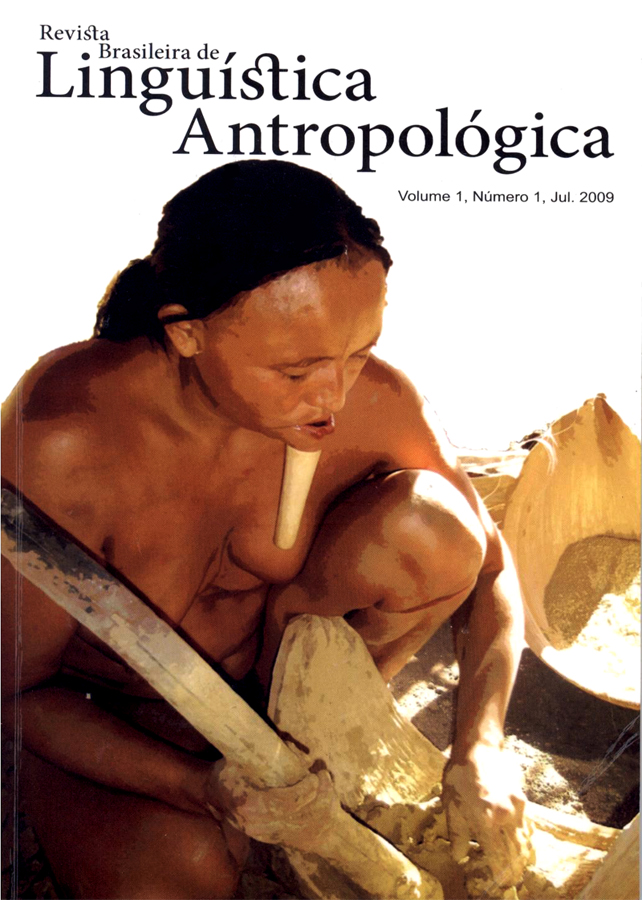Two Ergativities and Their Cultural Correlates
DOI:
https://doi.org/10.26512/rbla.v1i1.12286Palavras-chave:
Tupí-Guaraní; Jê; ergativity; cultural correspondences; Amazonian languages.Resumo
Two Ergativities and Their Cultural Correlates proposes a distinction between two types of languages with ergative structures: a group which includes languages partially ergative from the Jê family, and another group of languages constituted mainly by languages also partially ergative from the Tupí-Guaraní family. We discuss the cultural correspondences of these two types of ergative structures, based on observations of various Amazonian indigenous groups: some Jê groups, on the one hand, and various Tupí-Guaraní groups, on the other hand, among which, the Kawahíwa, Kayabí and Araweté, whose cultures will be focused.
Downloads
Referências
Aikhenvald, A.; R. M. W. Dixon, 1999. Other Small Families and Isolates. The Amazonian Languages. Cambridge: Cambridge University Press, 341-378.
Betts, LaVera. 1984. Esboço gramatical. In: Dicionário Parintintin-Português, Português-Parintintin. Brasília: Summer Institute of Linguistics, pp. 10-20.
Boas, Franz. 1911. Handbook of American Indian languages, Vol. 1. Bureau of American Ethnology, Bulletin 40. Washington: Government Print Office (Smithsonian Institution, Bureau of American Ethnology).
Cabral, Ana Suelly A. C.; Aryon D. Rodrigues; Lucivaldo da Silva Costa. 2003. Notas sobre ergatividade em Xikrin. Liames 4: 21-28.
Castro, Eduardo B. Viveiros de. 1986. Araweté: os deuses canibais. Rio de Janeiro: Jorge Zahar.
Derbyshire, D. 1999. Carib. In: R. M. W. Dixon and Alexandra Aikhenvald (eds.), The Amazonian Languages, Cambridge University Press, pp. 23-64.
Franchetto, B. 1990. Ergativity and nominativity in Kuikuru and other Carib Languages. In: Doris L. Payne (ed.), Amazonian Linguistics. Austin: University of Texas Press, pp. 407-427.
Jensen, Cheryl. 1990. Cross-referencing changes in some Tupí-Guaraní languages. In: Doris L. Payne(ed.), Amazonian Linguistics. Austin: University of Texas Press, pp.117-158.
Payne, Doris. 1990. Transitivity and ergativity in Panare. In: Doris L. Payne (ed.), Amazonian Linguistics. Austin: University of Texas Press, pp. 429-453.
Rodrigues, Aryon. 1999. Macro-Jê. In: R. M. W. Dixon and Alexandra Aikhenvald (eds.), The Amazonian Languages. Cambridge University Press, pp. 165-206.
Sapir, Edward. 1949 [1933]. Language. In: David G. Mandelbaum (ed.), Selected Writings of Edward Sapir in Language, Culture and Personaity. Berkeley: University of California Press, pp. 7-32.
Seki, Lucy. 1990. Kamaiurá as an active-stative language. In: Doris L. Payne (ed.), Amazonian Linguistics. Austin: University of Texas Press, pp. 367-391.
Urban, Greg. 1985. Ergativity and accusativity in Shokleng (Gê). IJAL, 51: 164-187.
Urban, Greg. 1991. A Discourse-centered Approach to Culture: Native South American Myths and Rituals. Austin: University of Texas Press.
Downloads
Publicado
Como Citar
Edição
Seção
Licença
Copyright (c) 2012 Revista Brasileira de Linguística Antropológica

Este trabalho está licenciado sob uma licença Creative Commons Attribution 4.0 International License.
Autores que publicam na RBLA concordam com os seguintes termos:
a) Autores mantêm os direitos autorais e concedem à revista o direito de primeira publicação, sendo o trabalho simultaneamente licenciado sob a Creative Commons Attribution License, o que permite o compartilhamento do trabalho com reconhecimento da autoria do trabalho e publicação inicial nesta revista.
b) Autores têm autorização para assumir contratos adicionais separadamente, para distribuição não exclusiva da versão do trabalho publicada nesta revista (ex.: publicar em repositório institucional ou como capítulo de livro), com reconhecimento de autoria e publicação inicial nesta revista.
c) Autores têm permissão e são estimulados a divulgar seu trabalho online (ex.: em repositórios institucionais ou na sua página pessoal) a qualquer ponto antes ou durante o processo editorial, já que isso pode gerar alterações produtivas, bem como aumentar o impacto e a citação do trabalho publicado.







